Students must start practicing the questions from CBSE Sample Papers for Class 11 Biology with Solutions Set 2 are designed as per the revised syllabus.
CBSE Sample Papers for Class 11 Biology Set 2 with Solutions
Time : 3 Hours
Maximum Marks : 70
General Instructions:
- All questions are compulsory.
- The question paper has five sections and 33 questions. All questions are compulsory.
- Section – A has 16 questions of 1 mark each; Section – B has 5 questions of 2 marks each; Section – C has 7 questions of 3 marks each; Section- D has 2 case – based questions of 4 marks each; and Section – E has 3 questions of 5 marks each.
- There is no overall choice. However, internal choices have been provided in some questions. A student has to attempt only one of the alternatives in such questions.
- Wherever necessary, neat and properly labeled diagrams should be drawn.
Section – A
Question 1.
Different cells have different sizes. Arrange the following cells in an ascending order of their size. Choose the correct option among the followings: (1)
(i) Mycoplasma
(ii) Ostrich eggs
(iii) Human RBC
(iv) Bacteria
Options:
(A) (i), (iv), (iii) & (ii)
(B) (i), (ii), (iii) & (iv)
(C) (ii), (i), (iii) & (iv)
(D) (iii), (ii), (i) & (iv)
Answer:
Option (A) is correct.
Explanation: Mycoplasma or PPLO (Pleuro Pneumonia Like Organism) is smallest prokaryotic cell and ostrich egg is the largest ever known cell.
Question 2.
Given below are the types of cells present in some animals. Each one is specialised to perform a single specific function except: (1)
(A) Choanocytes
(B) Interstitial cells
(C) Gastrodermal cells
(D) Nematocytes
Answer:
Option (B) is correct.
Explanation: Out of all these cells interstitial cells can arise any kind of cells in animal body. other cells have their individual functions.
Question 3.
Match column A with column B and choose the correct option: (1)
| Column A | Column B |
| (a) Porifera | (i) Canal system |
| (b) Aschelminthes | (ii) Water-vascular system |
| (c) Annelida | (iii) Muscular Pharynx |
| (d) Arthropoda | (iv) Jointed appendages |
| (e) Echinodermata | (v) Metameres |
(A) a – ii, b – iii, c – v, d – iv, e – i
(B) a – ii, b – v, c – iii, d – iv, e – i
(C) a – i, b – iii, c – v, d – iv, e – ii
(D) a – i, b – v, c – iii, d – iv, e – ii
Answer:
Option (C) is correct.
![]()
Question 4.
A plant shows thallus level of organisation. It shows rhizoids and is haploid. It needs water to complete its life cycle because the male gametes are motile. Identify the group to which it belongs to: (1)
(A) Pteridophytes
(B) Gymnosperms
(C) Monocots
(D) Bryophytes
Answer:
Option (D) is correct.
Explanation: Division Bryophyte have thaUoid body, haploid rhizoids (root like structure) and need water for the sexual reproduction.
Question 5.
Rearrange the following zones as seen in the root in vertical section and choose the correct option. (1)
(I) Root hair zone
(II) Zone of meristems
(III) Root cap zone
(IV) Zone of maturation
(V) Zone of elongation
Options:
(A) III, II, V, I, IV
(B) I, II, III, IV, V
(C) IV, V, I, III, II
(D) V, IV, III, II, I
Answer:
Option (A) is correct.
Question 6.
In frog, digestion of fats occurs mostly in: (1)
(A) Rectum
(B) Stomach
(C) Duodenum
(D) Small intestine
Answer:
Option (D) is correct.
Explanation: In frogs most of the digestion occurs in small intestine, which is divisible into duodenum and ileum.
Question 7.
Which of the following plants is used to extract the blue dye? (1)
(A) Trifolium
(B) Indigof era
(C) Lupin
(D) Cassia
Answer:
Option (B) is correct.
Explanation: Indigo (blue)dye is extracted from the leaves of Indigofera tinctoria these leaves have a colourless chemical which tuns to bluish color after exposure to air.
Question 8.
Identify the given labelled parts. (1)
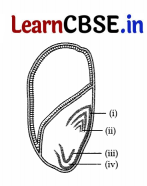
(A) (i) – Coleoptile, (ii) – Coleorrhiza, (iii) – Plumule, (iv) – Radicle.
(B) (i) – Plumule, (ii) – Radicle, (iii) – Coleoptile, (iv) – Coleorrhiza.
(C) (i) – Coleoptile, (ii) – Plumule, (iii) – Radicle, (iv) – Coleorrhiza
(D) (i) – Radicle, (ii )- Coleorrhiza, (iii) – Coleorrhiza, (iv) – Plumule.
Answer:
Option (C) is correct.
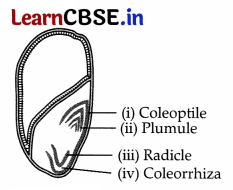
Question 9.
Contagium vivum fluidum was proposed by: (1)
(A) D.J. Ivanowsky
(B) M.W Beijerinck
(C) Stanley
(D) Robert Hooke
Answer:
Option (B) is correct.
![]()
Question 10.
Identify the ‘bath sponge’ among the following. (1)

(A) (i)
(B) (ii)
(C) (iii)
(D) (iv)
Answer:
Option (B) is correct.
Explanation: Bath sponge is the common name for Euspongia which is belongs to phylum porifera and it is commertially used sponge.
Question 11.
A transverse section of the stem is stained first with safranin and then with fast green following the usual schedule
of dtiuble staining for the preparation of a permanent slide. What would be the colour of the stained xylem and phloem? (1)
(A) Red and green
(B) Green and red
(C) Orange and yellow
(D) Purple and orange
Answer:
Option (A) is correct.
Explanation: Xylem gives the red colour with safraninas its walls are lignified and picks up the red dye and appears pinkish in colour while fast green colour to cellulose.
Question 12.
Name the pigment whose absorption spectrum is represented as ‘X’. (1)
(A) Cholorophyll A
(B) Cholorophyll B
(C) Carotenoids
(D) Xanthophyll.
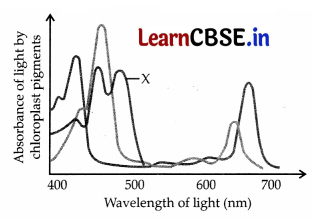
Directions: In the following questions, A statement of Assertion is followed by a statement of Reason (R).
Mark the correct choice as:
(a) Both Assertion (A) and Reason (R) are true and Reason (R) is the correct explanation of Assertion (A).
(b) Both Assertion (A) and Reason (R) are true but Reason (R) is NOT the correct explanation of Assertion (A).
(c) Assertion (A) is true but Reason (R) is false.
(d) Assertion (A) is false but Reason (R) is true.
Answer:
Option (C) is correct.
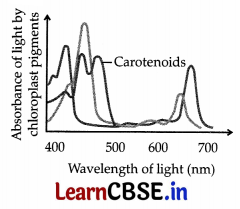
Question 13.
Assertion (A): Systematics is the branch of biology that deals with identification, naming and classification of the
organisms into groups. (1)
Reason (R): The aim of classification is to group the organisms.
Answer:
Option (B) is correct.
Explanation: Systematics is the branch of biology that deals with the identification, naming and classification of the organisms into groups. The aim of classification is to group the organisms.
Question 14.
Assertion (A): Trichoderma, Colletotrichum are called ‘imperfect fungi’. (1)
Reason (R): Sexual reproduction is absent in these forms.
Answer:
Option (A) is correct.
Explanation: Trichoderma, Colletotrichum are called imperfect because sexual reproduction is absent in these forms.
![]()
Question 15.
Assertion (A): The gymnosperms are heterosporous. (1)
Reason (R): They produce diploid microspores within sporangia.
Answer:
Option (C) is correct.
Explanation: Gymnosperms produce haploid microspore within microsporangia.
Question 16.
Assertion (A): Fish belonging to class osteichthyes have to swim constantly. (1)
Reason (R): Air bladder is present in these fishes.
Answer:
Option (D) is correct.
Explanation: Fishes belonging to class Chondrichthyes have to swim constantly. It is because air bladder is absent in these fishes therefore, they have to swim constantly to avoid sinking.
Section – B
Question 17.
What are the factors which set the limit of cell size? (2)
Answer:
The factors which set the limit of cell size or volume are:
(i) Nucleo-cytoplasmic ratio which determines the range of control of metabolic activities by nucleus.
Question 18.
Examine the figure.
(a) Name the labelled part (1) and (2). (2)
(b) Name the metabolic processes taking place in the places marked (1) and (3).
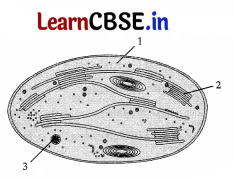
Answer:
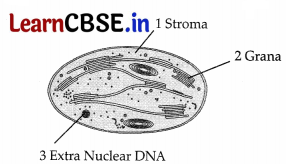
(a) 1 – Stroma , 2 – Grana.
(b) Label 1 represents the stroma of chloroplast, where the dark reaction of photosynthesis takes place. Label 3 represents extranuclear DNA. This DNA is responsible for replication of chloroplast.
Question 19.
(a) Identify the given diagram (A), (B) (2)
(b) Name the given labeled parts (a), (b).
(c) Write the functions of label a, b.
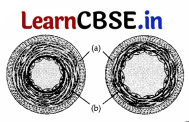
Answer:
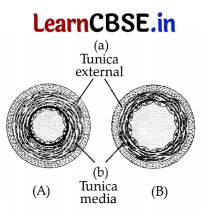
(a) (A)-Artery (B)-Vein.
(b) (a)- Tunica Externa (b)- Tunica Media.
: (c) Tunica externa: It is the outermost coat which is formed of connective tissues.
False
![]()
Question 20.
(a) Label any five features in a given diagram. (2)
(b) Name the hair like outgrowths which attach to the surface of other bacterial cells.
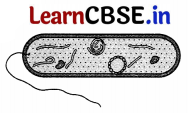
Answer:
(a)
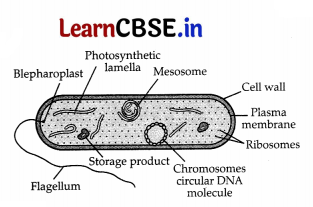
(B) Pili.
Question 21.
Histones are highly basic protein, abundant in lysine and arginine. (2)
They act as spools around which winds to form structural units called nucleosomes.
(a) Where does the histone protein found in cell?
(b) Mention the function of histone protein in eukaryotic cell.
OR
The table given below shows some characteristics feature of gram-negative and gram-positive bacteria. Based on the given information answer the following questions.
| Characteristics | Gram positive bacteria | Gram negative bacteria |
| Cell Wall | Present | Present |
| Gram Stain | Positive | Negative |
| Lipid Content | Low | High |
(a) What is the difference between gram-positive and gram-negative bacterial cell walls?
(b) Why does gram-negative bacteria doesn’t retain gram stain?
Answer:
(a) Histone protein is found in the nucleoplasm.
(b) Histone binds with negatively charged DNA forming octamers called nucleosome.
OR
(a)
| Gram-Positive Bacterial Cell wall | Gram-Negative Bacterial Cell wall |
| • The cell wall layer of gram-positive bacteria cell is single-layered thick. | • The cell wall layer of gram-negative bacteria cell is doublelayered thick. |
| • It retains the purple color of crystal violet dye when stained. | • It does not retain the purple color of crystal violet dye when stained. |
| • It contains thick layers of peptidoglycan which helps to retain the color of crystal violet dye. | • It contains thin layers of peptidoglycan. |
the cell wall of gram-negative bacteria contains thin layers of peptidoglycan . peptidoglycan is intact with lipoproteins between the double-layered cell wall and dissolves when alcohol is added .
Section – C
Question 22.
(a) Complete the flow chart given with proper labeling. (3)
(b) Name the process shown above and where does it occur.
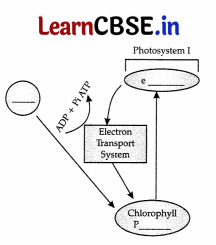
Answer:
(a)
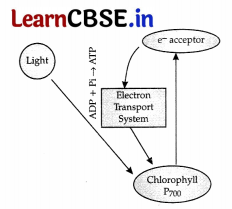
(b) The above shown flow chart is Cyclic Photophosphorylation of Photosystem I1.
This process occurs in the thylakoid membrane of chloroplast.
Question 23.
What is hepatic portal system? (3)
Answer:
Hepatic portal system:
- It carries blood from the alimentary canal and its associated glands to the liver.
- It consists of a large hepatic portal vein that receives a number of tributaries.
- The tributaries are namely oesophageal, gastric, duodena-pancreatic, intestinal, splenic and rectal.
Question 24.
The transverse section of a plant material shows the following features: (3)
Vascular bundles are conjoint, dosed and scattered and are surrounded by the sclerenchymatous bundles sheath.
(a) What will you identify it as?
(b) Write any other four features of this specimen.
Answer:
(a) It is a monocot stem. It is characterised by conjoint, collateral, and closed vascular bundles, scattered in the ground tissue containing the parenchyma. Each vascular bundles is surrounded by sclerenchymatous bundle-sheath cells.
(b) Other four features of monocot stem are : (a) (b) (b) (c) (d) (e) (f) (g) (h) (i) (ii) (iii) (iii) (iii) (iv) (v) (iv) (v) (iv) (v) (iv) (v) (iv) (iv) (v) (iv) (v) (iv) (
- Vascular bundles are scattered in the ground tissue.
- Y-shaped xylem endarch condition.
- Cambium is absent.
- Phloem parenchyma and medullary rays are absent in monocot stems.
![]()
Question 25.
(a) In the figure of the sigmoid growth curve given below, label segments 1,2 and 3. (3)
(b) Define 1,2 and 3.
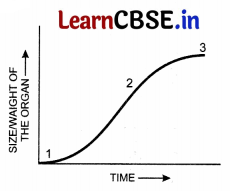
Answer:
(a) 1 – Lag phase.
2 – Exponential phase
3 – Stationary phase.
(b) In the given graph, 1- The lag phase is the initial growth phase, which is slow.
2 – Log or exponential phase, growth increases rapidly and with a limited supply of nutrients,
3 – Stationary phase.-The growth slows down again.
Question 26.
What is meant by tertiary structure of protein? Why a tertiary structure is essential for a protein? (3)
Answer:
The complex three dimensional shape formed by the coiling and folding of helical polypeptide chain is known as a tertiary structure of proteins. Such structure are held together by weak bonds formed between various parts of polypeptide chain. The biological activity of a protein molecule depends largely upon the specific tertiary structure.
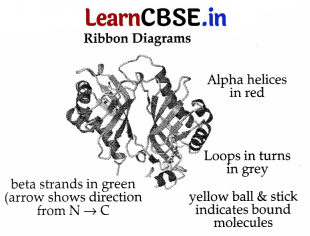
Question 27.
(a) Name the source gland of luteinising hormone (LH). (3)
(b) Mention the other hormone along with which it acts on its target cells/ organ.
(c) Give their two functions.
OR
(a) What hormones are secreted by the posterior pituitary gland?
(i) What function does each serve?
(ii) Where are these hormones actually produced?
(b) How are these hormones transported to the region from which they are released?
Answer:
(a) LH is secreted by adenohypophysis or anterior pituitary gland.
(b) FSH is the other hormone (gonadotropin) along with which its target cell.
Functions of LH:
(i) In males, it stimulates spermatogenesis.
(ii) In females, it stimulates ovulation and the formation of the corpus luteum.
(c) Functions of FSH:
1. In females, it stimulates the growth of ovarian follicles.
2. It helps in the regulation of menstrual cycle.
OR
(a) Oxytocin and vasopressin.
(i) Oxytocin: It is released into the blood when hypothalamic neurons are stimulated by the widening of the uterus at the time of delivery or by the sucking of breasts by an infant. It induces contraction of smooth muscles of the uterus during the birth of a young one and myoepithelial cells of mammary glands to infant. Therefore, it is also known as ‘birth hormones’ and or ‘milk-ejecting hormones’.
True
False
False
Question 28.
What are the conditions required for growth? (3)
Answer:
Growth is influenced by a number of conditions which are as follows:
- Water is required for cell elongation, maintenance of turgidity of growing cells and providing a medium for enzyme action.
- Oxygen is essential for aerobic respiration and hence the availability of energy for biosynthetic activity.
- Nutrients are raw materials for the synthesis of protoplasm, as well as the source of energy.
- Light is required for tissue differentiation, synthesis of photosynthetic pigments and photosynthesis.
- The optimum temperature for proper growth is 28 – 30°C.
- Environmental signals such as light & gravity also affect certain stages of growth.
Section – D
Question 29.
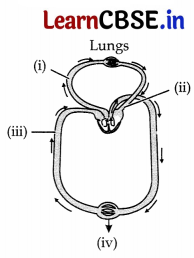
(a) What does the above diagram show. (4)
OR
Name the two pathways involved in the above process.
(b) In relation with the given diagram answer the following questions:
(i) label the given diagram.
(ii) Name the vein which carries the oxygenated blood.
(c) What is the significance of above given process.
Answer:
(a) The given diagram shows the process of – double circulation in human.
OR
The two pathways involved in double circulation are 1. Pulmonary circulation and 2. Systemic, circulation.
(b) (i)
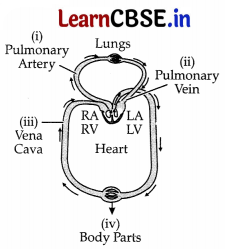
(ii) Pulmonary artery.
: (c) The deoxygenated and oxygenated blood remain separated and do not mix.
![]()
Question 30.
What does the above diagram show? (4)
(a) What does the above diagram show?
(b) Name the type of conduction.
(c) What is the nature of nerve impulses?
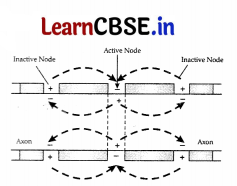
OR
Haemoglobin is a red coloured iron containing pigment present in the RBCs where O
2
can bind with haemoglobin. Similarly CO
2
is carried by haemoglobin. The oxygen dissociation curve is highly useful in studying the effect of factors like pCO
2
, H
+
concentration, etc., on the binding of O
2
with haemoglobin.
(a) Which pigment is formed when O
2
binds with haemoglobin?
(b) Which pigment is formed when CO
2
binds with haemoglobin?
(c) Name the factors favourable for the formation HbO
2
.
Answer:
(a) The above diagram shows the conduction of impulses along the myelinated nerve fiber.
(b) Along a myelinated nerve fiber, the conduction of impulse is called saltatory conduction.
(c) The nature of the nerve impulses is electrochemical.
OR
(i) Oxyhaemoglobin
(ii) Carbamino-haemoglobin
(iii) High pO
2
, low pCO
2
lesser H
+
concentration and lower temperature.
Section – E
Question 31.
All living organisms are made up of cell. Cell is the structural and functional unit of all organisms. (5)
The main structural and functional attributes of a cell are as follows:
| Cell organelle | Structure |
| Cell membrane (Found in all cells) | Composed of lipid and protein selectively permeable |
| Cell Wall (Found in plant cells, bacteria and Fungi, etc.) | Composed of cellulose and hemi-cellulose in plants. Rigid and strong. Composed of peptidoglycan in bacteria. Composed of chitin in fungi. |
| Mitochondria (Powerhouse of the cell) | Organelles with membrane folds called cristae. Semi-autonomous organelles |
| Lysosome (Digestive bag of the cell) | Tiny sac like structure surrounded by single, thin membrane. |
| Golgi apparatus | Consists of cisternae stacked together in parallel rows. |
With reference to the above table answer the questions as follows:
(a) What is the importance of chi tin in fungi?
(b) What is the role of peptidoglycan in bacteria?
(c) What is the function of lysosome?
(d) Which cell organelle is known as the packaging and dispatching unit of the cell?
OR
Based on the procedure and result, name the following tests which fall under the given categories.
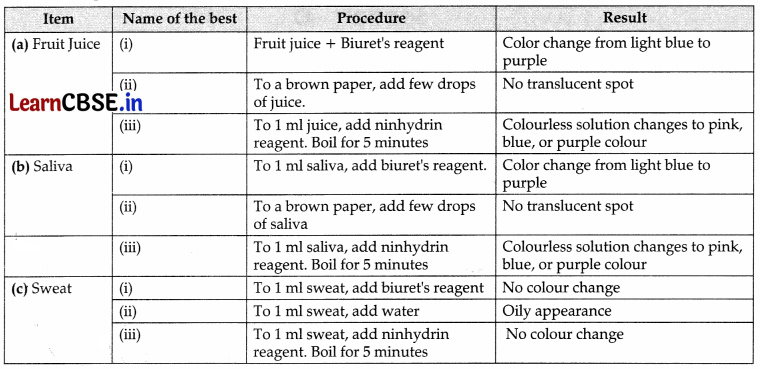
Answer:
(i) Chitin is a structural polysaccharide. It is present in cell walls of fungi and provides important structural stability.
(ii) It prevents bacteria from lysis due to turgor pressure, it also helps maintain cell shape and protects the cell from extreme environmental conditions.
(iii) Lysosome is a tiny sac-like structure surrounded by a single, thin membrane that contains digestive enzyme that helps in intracellular digestion.
(iv) Golgi apparatus.
OR
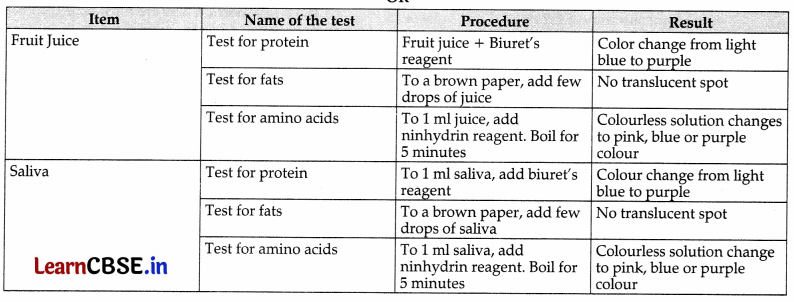

Question 32.
A neuron is a microscopic structure composed of three major part namely cell body, dendrites, and axon. The cell body contains cytoplasm with typical cell organelles and certain granular bodies called Nissl’s granules. (5)
(a) Which cells envelop myelinated nerve fibres ?
(b) Which type of neurons are found in eyes ?
(c) Which part of the neuron receives signal from another neuron?
OR
The Human brain is well protected by the skull. Inside the skull, the brain is covered by cranial meninges consisting an outer layer called dura mater, a very thin middle layer called arachnoid and an inner layer called Pia mater. The brain can be divided into three major parts: Forebrain, midbrain and hindbrain
(a) What are the three major regions which makes up the brain stem?
(b) Name the tract of nerve fibres which connects the two hemispheres of the brain.
(c) What is the role of hypothalamus?
Answer:
(a) Schwann cells envelop myelinated nerve fibres.
(b) Bipolar neurons have one axon and one dendrite found in retina of eye.
(c) Dendritic ends of neuron receives signal from another neuron.
OR
(a) Mid brain, Pons, and medulla oblongata are three major regions make up brain stem..
(b) Corpus callosum.
(c) Hypothalamus controls body temperature, urge for eating and drinking
![]()
Question 33.
Distinguish between: (5)
(a) Bony fishes and cartilaginous fishes.
(b) Exoskeleton and endoskeleton.
OR
Algae are known to reproduce asexually by variety of spores under different environmental conditions.
(a) Name the different types of spores.
(b) Write down the conditions which are required for the production of these spores.
(c) Give examples for each type of spores.
Answer:
(i) Differences between bony fishes and cartilaginous fishes:
| S. No. | Bony fishes | Cartilaginous fishes |
| (i) | They are called osteichthyes. | They are called chondrichthyes. |
| (ii) | Their endoskeleton is bony. | Their endoskeleton is cartilaginous. |
| (iii) | There are about 25,000 species known. | There are about 600 species known. |
| (iv) | They are found both in sea and fresh water. | All are marine forms. |
| (v) | They have swim bladder. | Swim bladder absent |
| (Vi) | Gills are covered by opercula. | They have five pairs of gills. Operculum absent. |
| (vii) | e.g., Salmon, Catla, Rohu, Bombay duck. | e.g., Skates and Rays, Scolidon, Electric ray. |
False
| S. No. | Exoskeleton | Endoskeleton |
| (i) | It is hard protective covering present over the body of many animals. | It is formed within the body of vertebrates. |
| (ii) | It is formed by the deposition of hard protective material on the surface of body. Invertebrate’s scales, nails, claws and feathers are exoskeleton. | It is formed of hard bone and cartilage. |
| (iii) | It helps in protection, has covering functions, and helps in quick movement. | It forms frame work of the body. It provides shape and posture to the body. It protects delicate organs of the body and helps in movement. |
OR
(a) Zoospores, aplanospores, hypnospores, stratospores and neutral spores.
(b)
(i) Zoospores: They are motile flagellated spores. Zoospore formation takes place during favourable conditions. During their formation, flagella are withdrawn and organisms come to rest. The protoplasm undergoes repeated divisions and forms 8-16 daughter protoplasts. These daughter individuals called zoospore develop their individual cell wall and flagella. The parent cell wall is lost and new individuals attain independent existence.
True
True
False
True
(c) Zoospores- e.g., Chlamydomonas.
Aplanospores-. e.g., Spirogyra
Hypnospores-e.g., Vaucheria.
Stratospores- eg. Diatoms
and Neutral spores- e.g., Ectocarpus.